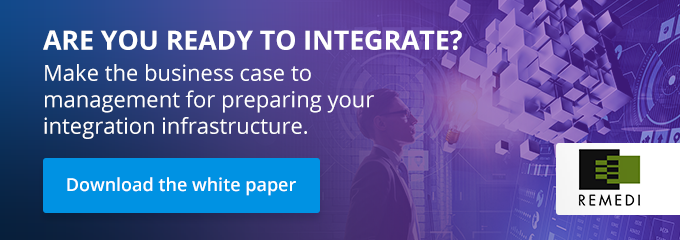
How do you look at modern B2B integration? Is it a cost center, or is it a competitive differentiator? If you answered “competitive differentiator,” you are on the right track. In fact, some modern B2B integration experts would even consider this concept to be a superpower.
While many people think that B2B integration is synonymous with EDI, that is not the case. Modern B2B integration encompasses more solutions than you may realize. Read on to learn about how these solutions give organizations in a variety of industries a competitive advantage.
Modern B2B Integration: Beyond EDI
Regarding modern B2B integration that goes beyond EDI, there are multiple new solutions out there that enable organizations to share information quickly and easily. Here are just four of them:
- APIs
- Hybrid integration
- Blockchain
- IoT
APIs
APIs stand for “application programming interfaces.” They let you consume a service, and they deliver that service in a way that an application can make use of it. For example, an API could connect a data source to a particular application.
The best way to think of APIs is to compare them to an electrical socket. When you plug a device or appliance into a socket, electricity flows through the socket to power that device. Sockets are also a standard way of delivering electricity to a device; within the US and Canada, sockets are shaped the same way and transfer the same amount of electricity when you plug something into them.
Why Use APIs?
Why should you consider using APIs? They offer five benefits:
- Instant information transfer: APIs offer real-time information transfer. Within a few clicks, you can call up an API that can give you data on what’s going on, right now. Suppose you want to know an order’s status. An API can tell you within moments that it was shipped yesterday, and that it is in transit. That is a valuable capability; your customers do not want to wait, only to find out there has been a delay in their shipment.
- Faster deployment:When APIs were initially developed, they were code-intensive, fragile, laborious, and took time to develop. That is no longer the case. Today, developers use technologies such as JSON, OData, and Swagger OpenAPI Specification, which make it faster and easier to create APIs. Faster development means that you can releases your APIs sooner. You will gain opportunities for business growth (including monetization) with rapid development.
- Greater connectivity to information services: APIs also connect to a higher number of information sources than EDIs do. They link to databases, applications, and a number of other systems. Their lightweight nature makes them suitable for connecting to mobile devices. In contrast, EDI systems are “heavier.” They require careful management, and connections are more difficult to make. That being said, you can combine EDIs and APIs for the best of both worlds.&
- Ability to overcome the deficiencies of other architectures: Over the years, software developers have created architectures to facilitate information sharing. APIs are the latest in a line of architectures including service-oriented architecture (SOA) and the enterprise service bus (ESB). SOAs and ESBs each have their benefits as well as drawbacks. They are both meant for internal interactions. APIs, on the other hand, specify how software components should interact with one another, including how external data sources (such as Big Data and social media) connect to applications.
- Easier onboarding: Onboarding represents one of the biggest challenges for trading partners, especially when there is a mix of cloud and legacy technologies as well as an assortment of integration techniques.
Again, the combination of EDI and APIs can save the day. EDI protocols such as AS2 are necessary for certain processes, while API support comes in handy for both cloud and on-premises applications.
Hybrid Integration
There are four integration methods:
- On-Premises – Integration software is installed on a server at an organization’s site.
- Hosted – Integration software is installed on a server off-site.
- Cloud – Integration software is delivered over the internet.
- Hybrid – Integration functionality utilizes two or more of the above methods.
While there are valid reasons why a firm might consider each of these methods, there are four major reasons why a firm would consider a hybrid integration approach:
- Security: Pure cloud and even hosted deployments are not as secure as the on-premises version. That is the advantage of a hybrid approach. With a hybrid approach, you have greater control over your security because the deployment is on-site. However, you still reap the benefits of being in the cloud.
- Regulations: The issue of security is tightly linked to regulations. Many jurisdictions have regulations in place that dictate what can and what cannot be stored or transmitted through the cloud. Using the hybrid approach, you can still use the cloud to a certain extent while complying with laws because you are still also using on-premises resources.
- Control and Customization: A hosted or cloud deployment means that the service provider controls your data. When the deployment is on-premises, you have control over your information. Hybrid B2B integration also allows you to customize your software. Pure cloud and hosted B2B integration software is not easily customizable because it is built to be frequently deployed. On-premises software, on the other hand, is designed for customizations (and integrations).
- Costs:The cost of infrastructure has dropped recently. It is now more cost-effective to create a private cloud. Private clouds provide the security of an on-premises deployment with the flexibility of a public cloud. You will even be able to pass those savings on to your customers.
Blockchain
A new player in the modern B2B integration technology scene is blockchain. Today, blockchain can augment your existing EDI system.
The blockchain is a shared digital ledger that records transaction history. Once you enter a transaction, you cannot change what is stored in it. Before entering a new transaction into the ledger, all parties have to agree to it.
While blockchain conjures images of cryptocurrency traders, this technology has a number of use cases for the supply chain:
- Traceability: Today, everyone wants to know where their products are coming from. Blockchain enhances traceability by tracking a product’s manufacturing journey, from raw materials to its trip to the shelf.
One example comes from the world of coffee. Bext Holdings, a Denver startup, created bext360 to generate a record of coffee beans’ origins and purchase price. Ireland’s Moyee Coffee shows customers real-time payments to growers in Ethiopia. - Security:The blockchain also promotes security. Security is vital in every industry related to manufacturing. Here is another food and beverage industry example to illustrate. A few years ago, Walmart and IBM joined forces to increase food security with a blockchain ledger. Walmart’s partners enter origin and processing information into ledgers. In 2018, Walmart put a food-tracking blockchain into place.
- Efficiency: Everyone wants to be more efficient, yet there are many barriers to achieving that goal. Blockchain offers a solution, though. TradeLens, a blockchain solution supported by IBM and Maersk, aims to make the supply chain more efficient by providing a predictable, secure exchange of information to speed up processes. Blockchain digitizes and automates processes such as import and export clearance, so there are no more time-wasting arguments over paperwork mistakes.
- Profitability: Inefficiency eats into profits. When you have to complete processes twice (such as duplicating paperwork for trading partners in the supply chain), that costs you money. Blockchain ledgers eliminate those costs because they work on a single shared ledger. No one can falsify or update a ledger entry after it has been made. Only parties writing valid transactions to the ledger can update it, and the ledger can verify that trading partners are who they say they are. Dual-key public encryption ensures that only authorized parties can read entries.
IoT
IoT (otherwise known as the Internet of Things) is disrupting B2B enterprises. IoT relies upon networked devices to transmit information without human intervention. This data goes into repositories, where it is analyzed for trends.
What does IoT have to do with integration? IoT is becoming a fixture in the B2B landscape. The information networked devices transmit is valuable; sensors tell you about the conditions in shipping containers or whether you need to order more raw materials. Knowing these things can save you money or allow you to embrace new opportunities.
However, to get the most out of IoT, you have to be able to integrate those data streams into your current workflows. Being able to do this offers you a competitive advantage because you can share more valuable information with your customers.
Modern B2B integration can offer you a competitive advantage (and maybe your customers will see it as a superpower). When you modernize your B2B integration technologies, you’ll stand out from the crowd.Are you ready to integrate?




